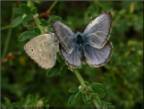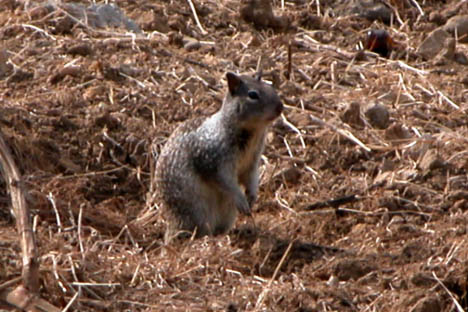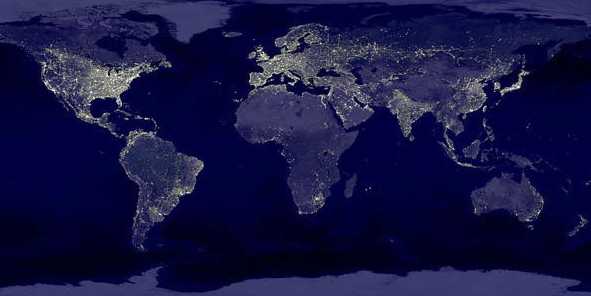|
The Urban Wildlands Group The Urban Wildlands Group is dedicated to the protection of species, habitats, and ecological processes in urban and urbanizing areas.
|
Ecological Consequences of Artificial Night Lighting: Conference Abstracts |
|


Los Angeles, California Conference Co-Chairs Abstracts
Plant photoreceptors:
proteins that perceive information vital for plant
development from the light environment As sessile organisms, higher plants rely heavily on environmental signals to guide their development. Among the more important environmental signals are those that come from their light environment. Thus in the course of evolution plants have acquired a wide range of photoreceptors that perceive and respond to light signals in the ultraviolet, blue, red, and near-infrared regions of the electromagnetic spectrum. In the model plant Arabidopsis thaliana, nine different photoreceptors have been characterized. Those absorbing and responding to UV-A and blue wavelengths of light include two cryptochromes, cry1 and cry2, and two phototropins, phot1 and phot2. Those absorbing in the red and far-red regions of the spectrum are the five phytochromes. There is also evidence for photoreceptors that sense and respond to UV-B, although these remain to be characterized. These many photoreceptors allow the plant to measure and respond to four parameters of the light environment: light spectral quality, light intensity, light direction, and light duration. Sometimes these photoreceptors act independently, sometimes redundantly, sometimes cooperatively, sometimes antagonistically, sometimes at the same stage of development, and sometimes at different stages of development. Some of the responses are incredibly sensitive, responding to levels of light that even the human eye can barely perceive. Among the many processes affected by light are seed germination, stem elongation, leaf expansion, conversion from a vegetative state to a flowering state, flower development, fruit development, and senescence. There is virtually no rigorous research on the influence of urban lighting on plants. There are anecdotal reports of leaves of deciduous trees failing to senesce in proximity to streetlights because they perceive a long day instead of a short one, but little else. While it is highly likely that urban light does affect plant development, research is badly needed to assess what the effects might be.
Measuring light
pollution in urban lakes and its effects on lake
invertebrates Lakes or coastal waters in or near cities may experience high levels of artificial light at night, because they are generally not shaded by trees or buildings. Predicting ecological effects of this light on submerged organisms requires estimating the amount of artificial light at the water's surface and the depth of its penetration. This has never been done, in part, because no light meters are available commercially for quantifying such low light intensities either at the surface of aquatic habitats or underwater. We obtained two independent measures of the intensity of artificial lighting at the surface of five lakes by using two different instruments: 1) a custom-built light meter containing a photomultiplier tube, and 2) a modified diode-array spectrometer. The lakes ranged in location from inner city Boston, Massachusetts to within the White Mountains National Forest, New Hampshire. We also measured the spectral distribution of the artificial light, and we estimated its depth of penetration underwater. Spectra of the artificial light striking all urban and suburban lakes were nearly identical, and were dominated by light in the yellow region with a peak centered at approximately 590 nm and a width at halfheight of approximately 55 nm. These spectra closely matched the emission spectrum of high-pressure sodium lamps, the most common street lamp in the USA. Incident levels of artificial light at an urban lake (on the order of 10-3 µE m-2 s-1) were similar to the light intensity emitted from a full moon and nearly 50 times greater than that of a rural lake illuminated by starlight only. On average, suburban lakes experienced artificial light intensities 5-30 times greater than that of the rural lake. Cloud cover increased incident levels of artificial light two- to threefold. The depth to which this artificial light is biologically detectable underwater by crustacean grazers and fish was estimated to be approximately 3 meters using vertical extinction coefficients determined for the lakes in conjunction with published limits of light detection by aquatic organisms. Potential effects of this light on submerged aquatic organisms and results from field experiments in which artificial light was manipulated will be discussed.
Artificial night
lighting and insects in Germany Nocturnal insects are extremely sensitive to outdoor lighting because they have evolved special adaptations of photoreception. They are often attracted to perform endless turns in the light sphere of lamps, but there are other exogenous and endogenous factors that control their behavior. The death struggle of insects around light sources can be described by special effects, e.g. "captivation effect," "crash-barrier effect," or "vacuum cleaner effect." In many cases insects become disoriented by these effects and are no longer able to perform their basic functions of nutrition and reproduction. Some results from a study within a rural landscape of Germany will be presented, showing the impact of different street lamp types on insects during a full summer season. These differences were quantified as capture ratios regarding both the bulk of insect orders or special orders alone. Besides light quality, the habitat characteristics were revealed to be important in this context as well. Additionally, the influence of full and new moon, and of the evening temperature, on the nocturnal activity of insects will be shown. These facts suggest that outdoor lighting may be a serious threat to insects. Based on results from literature an attempt is made to calculate the dimension of insect mortality resulting from a street lamp pool of a larger city up to the whole area level of Germany. Thereafter some examples of how species and populations with different life strategies may be influenced by lighting are considered. Finally, examples of energy savings from converting older street lamp systems into modern systems will be shown, especially the change away from high-pressure mercury lamps, which may reduce energy costs and CO2 emissions significantly. The modernization of public lighting is beneficial both for township budgets and for the agenda of nature conservation, especially of insects.
Impact of artificial
lighting on moths Artificial lighting has been blamed for decreases in populations of moths. By disrupting moth navigation and suppressing flight, it interferes with mating, dispersal, and migration. It also disturbs feeding, oviposition, nocturnal vision and, possibly, circadian rhythms. It increases predation by birds, bats, spiders, and other predators. It traps moths in buildings, diverts moths into vehicular traffic, and burns or desiccates moths that fly into lamp housings. Almost all of these effects are a consequence of flight-to-light behavior. Most species of macrolepidoptera moths exhibit such behavior, and most kinds of lamps used for artificial lighting elicit it. However, many species of moths thrive near urban and suburban lighting. Destruction of vast numbers of moths in light traps has failed to eradicate moth populations. Extinctions due exclusively to artificial lighting have not been documented. Nevertheless, artificial lighting may weaken or eliminate small populations threatened by other disturbances, particularly in habitats fragmented by urban development. It generates selective pressure favoring evolutionary modification of flight-to-light behavior. Because parasitoids of some moth species fly to light, artificial lighting may disturb natural control of moth populations. Lighting should be restricted where protection of biodiversity is a high priority, such as in unusual ecological habitats, and in certain agricultural and horticultural settings. To limit artificial lighting, light sources should be turned off whenever illumination is not essential. Lamp housings should be sealed tight, and located away from structures that may trap insects. Low-pressure sodium lamps should be used in preference to other kinds of lamps.
Stray light, fireflies,
and fireflyers Fireflies (Lampyridae, Coleoptera) that use their chemiluminescence for sexual communication have a number of attributes that make them good as well as unique subjects when considering the effects of artificial light in natural environments. First, fireflies may be expected to have inappropriate "innate" responses to foreign light similar to those that occur in other organisms, but because of their conspicuous luminescent signals, some alterations may be more easily monitored and quantified. Second, because much of firefly life activity is mediated through their own pinpoints of light in otherwise dimly lit or dark environments, firefly relationship to light is virtually unique in the terrestrial world; thus, foreign light will have even more serious consequences for them, and they provide a special case for study. Fireflies may be useful as model systems for the study of the long- and short-term consequences of ecological insults that occur in combination. Third, because of their unique place in human culture, fireflies can be used as subjects as well as icons when educating and enlisting the help of the public, especially children and older students, and for reminding them of the continuing attention that is required to improve and then maintain healthy natural environments.
Observed and potential
effects of artificial light on the behavior, ecology,
and evolution of nocturnal frogs Most frogs are thought to be largely or completely nocturnal. About 3500 species of frogs inhabit a wide variety of fossorial, terrestrial, aquatic, and arboreal habitats and possess a wide variety of visual adaptations to these varied environments. Understanding frog natural history, activity patterns, and visual capabilities can greatly facilitate making predictions about the potential effects of light pollution on a given species. Experiments and anecdotal evidence demonstrate that both temporary and permanent changes to the illumination of an area may affect frog reproduction, foraging, predator avoidance, and social interactions. Laboratory experiments have demonstrated that dark-adapted frogs exposed to rapid increases in illumination may be temporarily "blinded" and unable to gather visual information on prey, predators, or conspecifics until their eyes adapt to the new illumination. Permanent increases in nocturnal illumination may facilitate or inhibit a variety of behaviors. Foraging may be facilitated in frogs that hunt around lights because the ambient illumination is increased to a level that allows the frogs to see prey or because lights attract abnormally large quantities of prey (e.g., insects). Reproductive activity may be inhibited in species that normally reproduce only at very low illuminations. Increased illumination may allow predators to see frogs that may not normally be visible to them. Circadian rhythms, activity patterns, and intraspecific visual communication may also be affected by increased illumination. Much more field and laboratory research is necessary to assess the full extent of direct and indirect effects of artificial night lighting on the behavior, ecology, and evolution of frogs.
The influence of
artificial illumination on the nocturnal behavior and
ecology of salamanders Little is known of the direct influence of artificial illumination on the biology of nocturnal salamanders. However, several studies provide evidence that artificial light may influence some aspects of their behavior and ecology. In this talk, the role of vision and the influence of light on the activity patterns, prey detection, predator avoidance, agonistic behavior, and orientation of salamanders to breeding ponds will be examined. Nocturnal foraging may be influenced by artificial illumination. In one species, salamanders emerge from refugia to forage within one hour after light levels drop dramatically following sunset. During such foraging bouts, visual information is useful for locating prey. Greater light levels may delay emergence (resulting in less foraging time) but increase the ability of salamanders to capture prey. However, such increases in light levels may also make salamanders more vulnerable to predation. Some salamanders are territorial and aggressively defend areas containing valuable resources. Increased illumination may alter the outcome of territorial contests. Laboratory experiments demonstrate that light levels affect behavioral interactions between conspecifics such that salamanders exhibit more visual displays when more light is available. Finally, many salamanders are terrestrial as adults but migrate to ponds to breed and lay eggs. The orientation of some species away from and toward these ponds is influenced by the spectral characteristics of light. Artificial lights that emit unusual spectra may disrupt these migration patterns. Because many salamanders are nocturnal and use visual cues for so many different biological functions, further experimentation on the influence of artificial illumination on the behavior and ecology of salamanders is warranted.
Lighting problems at
Florida's oceanic beaches: lessons learned from sea
turtles Florida's beaches are major rookeries for Western Atlantic loggerhead sea turtles, and minor rookeries for an increasing population of leatherback and green turtles. But coastal development in Florida continues unabated, increasing beach exposure to nocturnal illumination. As a consequence, the Florida coast has become a laboratory for testing methods designed to protect the turtles (nesting females and their hatchlings) from "photopollution." I first review how under natural conditions at night, females choose nest sites and hatchlings locate the sea from the nest. I then describe how both females and hatchlings are adversely affected by exposure to artificial lighting. I next critically evaluate two approaches to protecting hatchlings at local sites: nest manipulation and lighting modification. The second approach is more effective, though not always possible. Finally, I review the design, philosophy, and implementation of broad-scale plans to restore nesting beaches at the coastal community (Patrick Air Force Base), county (Broward County), and state (coastal roadway) levels. I argue that broad-scale planning best protects existing dark beaches, restores those currently exposed to moderate levels of lighting, and controls the lighting environment where new development is anticipated. The beneficiaries are sea turtles and other nocturnally-active organisms, as well as humans residing in coastal communities.
Artificial
night-lighting effects on salmon and other fishes in
the Northwest Teleost fish reaction to light stimulus depends upon fish physiologic adaptation to ambient light levels prior to exposure to light level changes. Laboratory studies examining the use of artificial light to guide juvenile salmon through migration barriers report measurable differences in fish responses to variations in the quantity and quality of artificial light. Studies in the Pacific Northwest report potential changes in fish migration behavior and the distribution of fishes in night-lighted areas. Such changes potentially increase mortality risks for salmon, herring, and sand lance. Juvenile chum and their predators, such as hake, dogfish, sculpin, large chinook, and coho, appear to congregate below night security lights with increased light intensities attracting the chum and potentially delaying outmigration; however, predator stomach analyses have not demonstrated heavy chum consumption in those conditions. In contrast, night lighting has also been found to attract juvenile herring and sand lance along with their predators, with heavy predation occurring on the herring and sand lance populations. Predators have also been known to take advantage of lighting at fish ladders, spillways, and bridges to prey on migrating salmon. The present limited number of in situ studies of artificial night lighting, coupled with the spatial and temporal limitations of existing studies, warrants further exploration to identify the extent of fish distribution changes over time and the real harm posed to these fishes. The potential changes in species abundance and dominance resulting from increased prey access under artificial lighting also warrant further exploration.
The behavioral
responses of migrating birds to different lighting
systems on tall towers Hundreds of species of birds typically migrate at night, and it is well known that fires and man-made lights attract birds during migration, particularly when the sky is cloudy and the ceiling is low. As early as 1886, E.A. Gastman reported that nearly 1,000 migratory birds were killed around electric light towers in Decatur, Illinois on a single evening. Exactly 110 years later a report for World Wildlife Fund Canada and the Fatal Light Awareness Program detailed the hazards of lighted structures and windows to migrating birds. In an effort to understand why birds are attracted to lights and to assess the influences of different types of warning light arrays on towers, we examined the behavior of nocturnal migrants flying near tall towers with different types of lighting. During spring migration we monitored flight behavior on 9 evenings near a strobe light FM radio tower and over a control area. During fall migration we monitored flight behavior on 14 evenings near a television tower with red lights, near a television tower with white strobe lights, and over a control area that had no tower. We used an image intensifier to monitor birds flying overhead, and coded the flight behavior of migrants into the following categories: linear flight (straight) and nonlinear flight (pause-hover, curved, or circling). During the spring study, the numbers of birds showing nonlinear flight near the tower with white strobe lights was significantly greater than at the control site, but the number of birds recorded at each site was not significantly different. During the fall study the number of birds showing nonlinear flight near the tower with red lighting was significantly greater than those flying near the tower with white strobes. The number of birds showing nonlinear flight near the tower with white strobes was significantly greater than those flying over the control site. Significantly more birds were recorded flying near the tower with red lights than flying near the tower with white strobes and over the control site. The number of birds detected flying near the tower with white strobes did not differ significantly from the number recorded over the control site. The greater number of birds near the tower with red lights is likely the result of "attraction" to the constantly illuminated lights on towers with red light arrays and the proportion of the time the birds showed nonlinear flight behavior. While birds in linear flight spend only a brief instant near the tower and leave the area, birds showing curved, circling, or hovering behavior spend more time near the tower and thus build concentrations of migrants in the area. Once concentrations build, the birds themselves may become collision hazards to other birds.
Artificial lighting and
the decline of seabirds
With only a very few exceptions
seabirds as a group are in decline worldwide.
Invariably, human activity is the driving force of
this global decline. Artificial lighting is one of a
suite of human impacts that together are contributing
to the downward trend in distribution and abundance
of the world's 300 species of seabirds. Artificial
lighting is believed to confuse seabirds while they
are migrating long and short distances, especially
while they move between urbanized nesting sites to
their feeding grounds at sea. Many seabirds are
nocturnal and move between land and sea at dusk or at
night and as such are particularly vulnerable to
artificial lighting. Once they are disoriented they
are at risk of colliding with artificial structures
such as buildings and transmission towers or of
falling onto roadways and being run over by vehicles.
One of the more dramatic examples of this is on the
island of Kauai where Newell's Shearwater
(Puffinus auricularis newellii) and Hawaiian
Petrel (Pterodroma phaeopygia sandwichensis)
are estimated conservatively to have declined to a
small fraction of their pre-development levels. A
community-wide salvage program called Save Our
Shearwaters (SOS) has done much over the last 30
years to ameliorate this human-induced mortality as
has a program to install shielded lighting around the
island. However, these efforts do not appear to
provide a sufficient offset to the mortality to
ensure the survival of these two endemic Hawaiian
seabirds.
Road illumination and
black-tailed godwit Black-tailed godwit (Limosa l. limosa) is an indicator species for the birdlife of open grassland in The Netherlands. The influence of road lights on the breeding population of this bird was studied in an area adjacent to a busy motorway. We compared one year, when the road lights were switched off, with the next year, when the lights were switched on. In a nearby second area, out of reach of influence of the traffic on the motorway, there were no lights in the first year. Early the next year 24 lights were installed. These were identical to the lights along the motorway and switched on and off simultaneously with them. All grassland parcels were individually characterized to eliminate field conditions that may influence the birds' nest choice. We then established the position of the nests, their distance to the motorway and to the temporary illumination, the measures of the eggs, and the date of laying of the first egg. The results reveal that road illumination has a statistically significant negative influence on the breeding habitat quality, reaching over several hundreds of meters. It is likely that the effect is suppressed by the nest fidelity of the birds, suggesting that the ultimate effect distance will be considerably larger. Moreover, birds that breed early seemed to choose their nest further away from the lights than birds that start later. A negative influence of the motorway (traffic noise) seemed to be absent. Apparently it can be compensated by favorable site factors. That the negative influence of illumination is not compensated suggests that this is stronger than the influence of the road.
Turning night into day:
the effects of artificial night lighting on
endangered and other mammal species This presentation will review the major studies designed to measure the effects of artificial lighting on mammals in the field and laboratory. The consequences of artificial lighting include general disruptions in daily activity cycles, and reductions in dispersal, foraging, and reproductive opportunities. Secondary effects on prey species, offspring rearing, and habitat reductions as a result of flooding habitat with lights are largely unexplored. In general, the research effort in this area needs to be further developed and pursued. As habitat continues to be fragmented by roads and other developments, the effects of artificial lighting will be exacerbated. Many species could potentially receive additional protection from habitat alterations, such as lights, if a substantial literature base existed. To demonstrate this point, a case study involving the protection of endangered ocelots in Texas from large floodlights installed at the US-Mexico border will be reviewed. This case study will demonstrate how difficult it is politically to protect a species from artificial lights in the absence of either a significant body of research about the effects of lights on mammals or a detailed study on the specific effects of lights on ocelots. Lastly, we will make recommendations about future studies that need to be undertaken in order to clearly demonstrate the effects of turning night into day for mammal species. |
|
|



